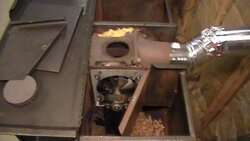Long time lurker, first time poster. Feels good to be official!
We've had our Prodigy II for about 6 years and it has always ran well. The door seal and glass seals have been ragged for some time so before the season, I decided to treat it to a tune-up.
I disassembled the stove and cleaned it immaculately. Replaced door and glass gaskets, oiled the motors, etc.
Now a couple interesting things have developed:
1) The stove generates way more ash than it used too, like triple the amount! Before I would only have to clean out the ash pan once a week...now it's every day, conservatively! The ash also has a different consistency...it's lighter and fluffier.
2) The glass gets dirty almost immediately. It use to creep in from around the gaps in the glass seal and slowly fill in the glass. Now it is an even coating on the glass within an hour of running, after a day you can't see through the glass anymore. It vacuums off easily, not sooty....just a coating of ash it seems. Especially bad on low speed (I know, most stoves don't run well on 1st speed) unfortunately it isn't quite cold enough to running on two or higher yet.
The flame is burning lively and bright orange, no black tips or blue flame. The flames are 3-4" high, about where they were before.
Could my feed rate be too high? Like I said, there aren't unburned pellets in the grate or ash pan so it seems like the rate is ok? I also cleaned the flue pipe (straight 3' horizontal pipe out the wall) so I know it isn't plugged.
I have the factory owners manual and downloaded a guide on using a mag gauge, etc but that all seems highly technical. Any ideas? I can post photos of the glass and burn if that helps.
*Sorry to be long winded but I forgot one more thing. We've been burning Pacific Pellets for several years and haven't had a problem. I'm burning a few bags leftover from last year and some fresh bags. They seem like there is more dust in them than I remember but that could just be my imagination. I believe they are mostly softwood pellets made from mill and casing off cuts.
We've had our Prodigy II for about 6 years and it has always ran well. The door seal and glass seals have been ragged for some time so before the season, I decided to treat it to a tune-up.
I disassembled the stove and cleaned it immaculately. Replaced door and glass gaskets, oiled the motors, etc.
Now a couple interesting things have developed:
1) The stove generates way more ash than it used too, like triple the amount! Before I would only have to clean out the ash pan once a week...now it's every day, conservatively! The ash also has a different consistency...it's lighter and fluffier.
2) The glass gets dirty almost immediately. It use to creep in from around the gaps in the glass seal and slowly fill in the glass. Now it is an even coating on the glass within an hour of running, after a day you can't see through the glass anymore. It vacuums off easily, not sooty....just a coating of ash it seems. Especially bad on low speed (I know, most stoves don't run well on 1st speed) unfortunately it isn't quite cold enough to running on two or higher yet.
The flame is burning lively and bright orange, no black tips or blue flame. The flames are 3-4" high, about where they were before.
Could my feed rate be too high? Like I said, there aren't unburned pellets in the grate or ash pan so it seems like the rate is ok? I also cleaned the flue pipe (straight 3' horizontal pipe out the wall) so I know it isn't plugged.
I have the factory owners manual and downloaded a guide on using a mag gauge, etc but that all seems highly technical. Any ideas? I can post photos of the glass and burn if that helps.
*Sorry to be long winded but I forgot one more thing. We've been burning Pacific Pellets for several years and haven't had a problem. I'm burning a few bags leftover from last year and some fresh bags. They seem like there is more dust in them than I remember but that could just be my imagination. I believe they are mostly softwood pellets made from mill and casing off cuts.



